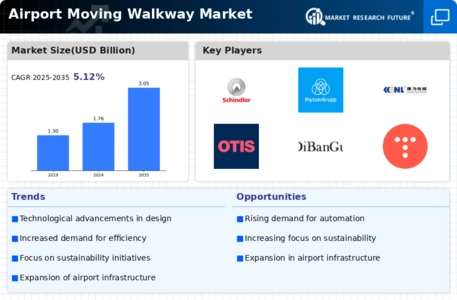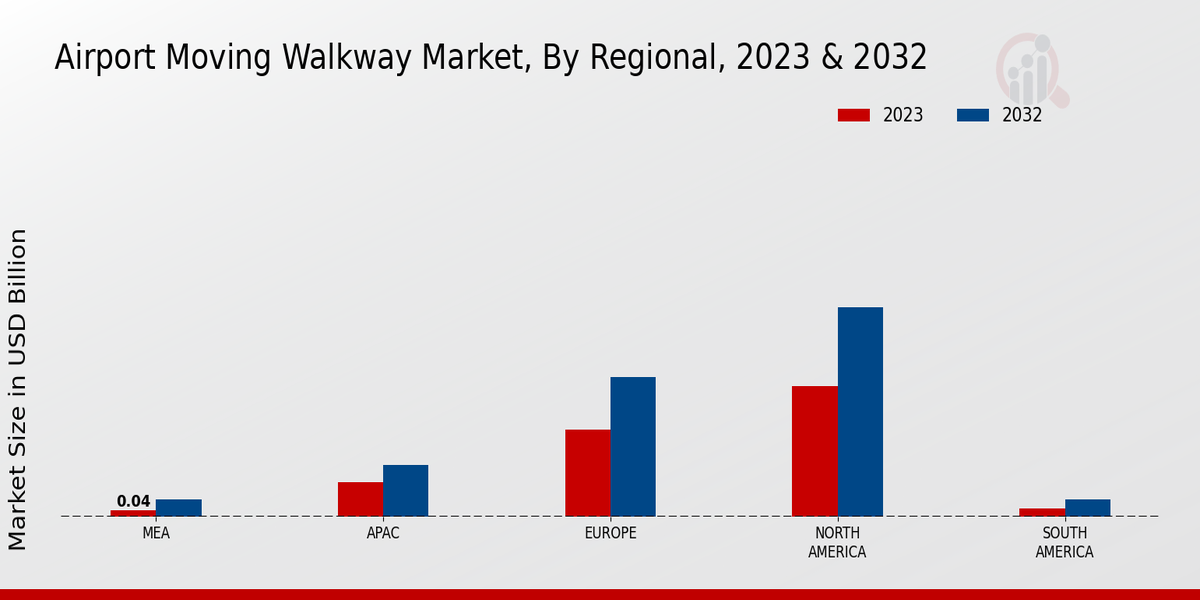Focus on Accessibility
The Global Airport Moving Walkway Market Industry is also driven by a heightened emphasis on accessibility for all passengers. Airports are increasingly recognizing the importance of providing seamless access for individuals with mobility challenges. Moving walkways play a crucial role in ensuring that all travelers can navigate terminals with ease. This focus on inclusivity aligns with global standards and regulations aimed at enhancing accessibility in public spaces. As airports expand and renovate their facilities, the integration of moving walkways is becoming a fundamental aspect of design, thereby fostering a more inclusive travel environment.
Market Growth Projections
The Global Airport Moving Walkway Market Industry is projected to grow at a CAGR of 5.12% from 2025 to 2035. This growth trajectory indicates a robust demand for moving walkways as airports continue to evolve and adapt to changing passenger needs. The increasing focus on enhancing passenger experience and operational efficiency is likely to drive further investments in moving walkway technology. As airports expand and modernize, the integration of moving walkways will become increasingly common, reflecting the industry's commitment to improving travel efficiency and accessibility.
Sustainability Initiatives
Sustainability initiatives are increasingly influencing the Global Airport Moving Walkway Market Industry. Airports are under pressure to reduce their carbon footprints and enhance energy efficiency. Moving walkways that utilize renewable energy sources or energy-efficient technologies are becoming more prevalent. These initiatives align with global efforts to promote sustainable practices in the aviation sector. Airports that adopt such technologies not only contribute to environmental sustainability but also appeal to eco-conscious travelers. As the industry moves towards greener solutions, the demand for sustainable moving walkways is likely to rise, reflecting a broader commitment to environmental responsibility.
Technological Advancements
Technological innovations are propelling the Global Airport Moving Walkway Market Industry forward. Modern moving walkways are equipped with advanced features such as energy-efficient motors, smart sensors, and user-friendly interfaces. These enhancements not only improve operational efficiency but also contribute to sustainability efforts within airports. For instance, the implementation of energy-saving technologies can reduce operational costs significantly. As airports strive to modernize their infrastructure, the adoption of these advanced moving walkways is likely to increase, reflecting a broader trend towards smart airport solutions that cater to the needs of contemporary travelers.
Increased Passenger Traffic
The Global Airport Moving Walkway Market Industry is experiencing growth due to a rise in global air travel. In 2024, the market is valued at 1.76 USD Billion, driven by increasing passenger numbers at airports worldwide. As more travelers utilize air transport, the demand for efficient movement within terminals escalates. Airports are investing in moving walkways to enhance passenger flow and reduce congestion, thereby improving overall travel experience. This trend is particularly evident in major international airports, where the integration of moving walkways is becoming a standard feature to accommodate the growing influx of passengers.
Expansion of Airport Infrastructure
The ongoing expansion of airport infrastructure is a significant driver for the Global Airport Moving Walkway Market Industry. With the projected market growth to 3.05 USD Billion by 2035, airports are investing heavily in new terminals and upgrades to existing facilities. This expansion often includes the installation of moving walkways to facilitate efficient passenger movement. For example, major airports in Asia and the Middle East are undergoing extensive renovations that incorporate moving walkways as a standard feature. Such developments not only enhance operational efficiency but also improve the overall passenger experience, making air travel more convenient.





















